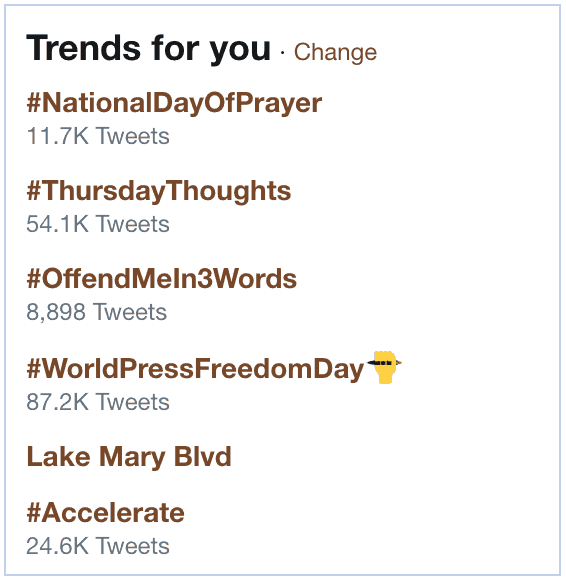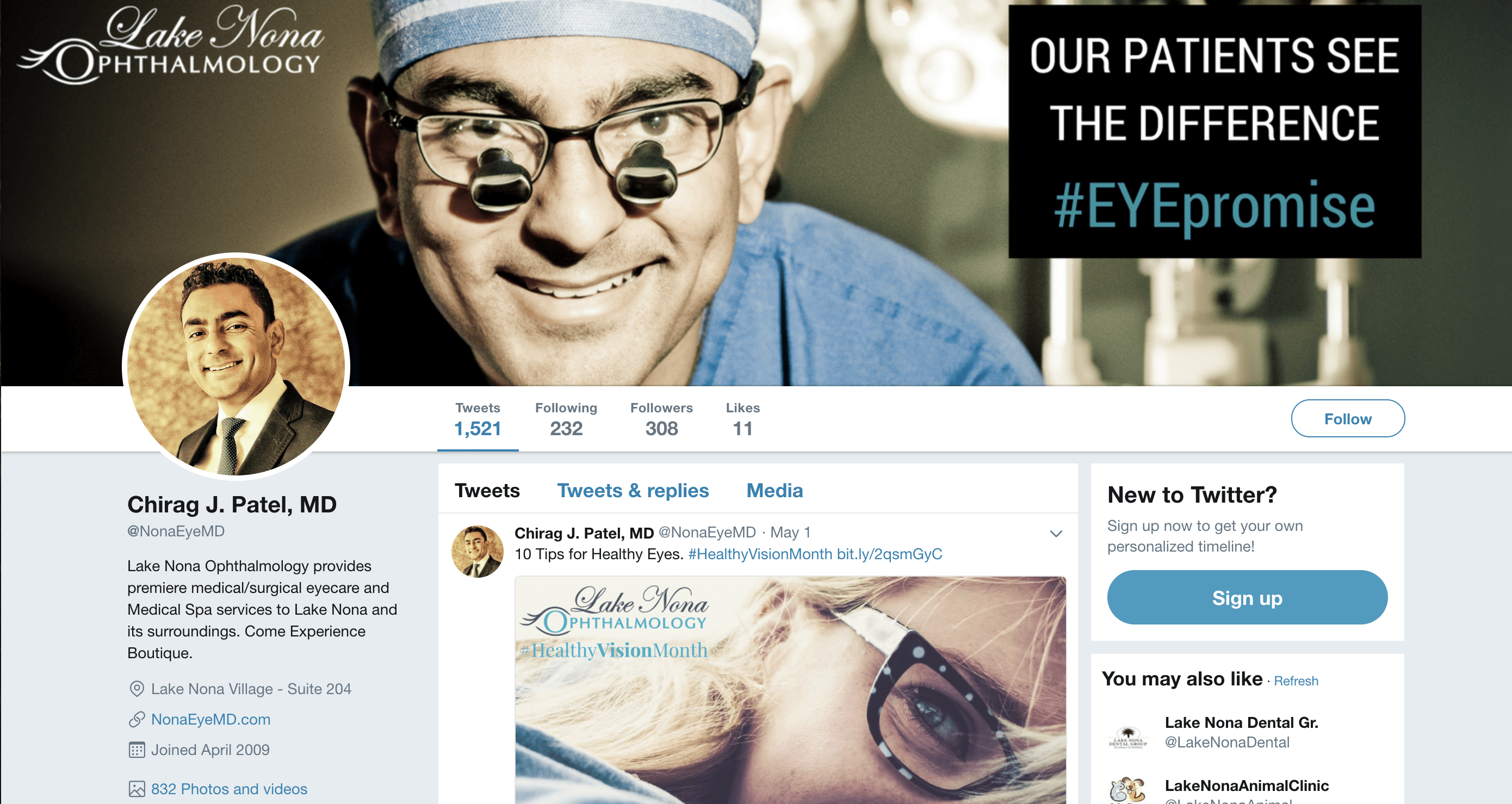 Can you use Twitter to help manage negative reviews, enhance customer care, boost employee engagement, and attract those coveted 5-star ratings?
Can you use Twitter to help manage negative reviews, enhance customer care, boost employee engagement, and attract those coveted 5-star ratings?
Yes, yes, yes, and YES.
Healthcare has been one of the slower industries to adapt to social media (and for valid reasons). However, if you’re one of the doctors or medical practice managers that has seen the light and realized the power of social media to reach your patients where they spend a LOT of their time, you’re ahead of the game.
Twitter allows you to build a direct link between your medical practice and your community, who are made up of current and former patients, researchers, colleagues, and industry peers looking to collaborate.
Regular, ongoing communication with your audience can help solidify and build your patient base, expand your reach to colleagues, peers, and leaders in your specialty, and provide lasting benefits to your medical practice.
Below we’ll share 8 ways you can hit a home run on Twitter and start using it today to engage your patients, employees, and community-at-large to solidify your reputation online and drive medical marketing success.
1. Understand What Twitter is
So what exactly is Twitter?
Although Facebook is the “big fish” in the social media pond, it’s certainly not the only one. The fact is that practice managers who limit their social media strategy to Facebook will be missing out on significant opportunities.
One rung down the social media food chain is Twitter, the fastest-moving social networking service. Twitter allows users to send, receive, and read 280-character text messages called “tweets”. Users can post messages, photos and short videos to a public profile or send direct messages to other users. Almost from its inception, Twitter quickly meshed with the media industry as it proved ideal for announcing breaking news stories, for politicians and public figures to share their thoughts in real-time, and for the occasional celebrity tantrum.
Like Facebook, Twitter has experienced tremendous growth over the last decade, expanding from 30 million monthly active users in 2010 to 330 million towards the end of 2017. A quarter of American adults online now use Twitter, up from 18% in 2013. Moreover, more than 40% of Americans who use Twitter report that they check in to the platform daily. And medical practice managers take note: 42% of Twitter users are between the ages of 25 and 44 years old, and 40% of users are aged 45 and older.
In a nutshell, people use Twitter to invent, discover, and share. Businesses and organizations of all ilk leverage the microblogging platform to forge connections with their audience, share news, events, and updates, and to initiate conversations with their community. The companies and brands hitting home runs on Twitter are those that post and share regular (multiple times daily), high-quality, and unique content with their audience.

2. Know Why Twitter Matters
So, can 280 characters really help market your medical practice?
You bet.
Social media has changed the way people communicate and interact with each other. Many people now prefer to read a text message or check their Twitter feed rather than waste precious minutes talking on the phone or checking voicemail.
Twitter gives you the capacity to engage with patients, other organizations, and your audience in real-time. Used properly, Twitter can give your practice a genuine “voice” that your patients (and employees) will identify and connect with.
Twitter can help you stay in touch with existing patients, help you attract new patients, and boost your reputation online. The time you put in growing your audience on Twitter will come back to you in spades later on as your Twitter followers will very quickly become some of your best brand advocates.
Last but certainly not least, Twitter can also provide your practice with an honest, real-time (free) barometer of how you are performing. The platform opens the pathways for your patients to celebrate and accentuate your successes, express their concerns, and provide valuable feedback on how to improve your overall quality of care. Hardly anyone these days will fill out a “Give Us Your Feedback” questionnaire, but many of your patients will naturally post a quick tweet to let you know about their experience.
Important note: It’s obvious that Twitter poses great potential for enhancing communication between you and your patients. However, as with Facebook and other social media platforms, you’ll need to show sound judgment and discretion vis a vis privacy and ethical standards, and be diligent to never “tweet” anything that would violate HIPAA standards and codes of conduct relating to patient privacy.
For a full discussion on how to stay HIPPA-compliant on social media, you can read our recent article here: https://insightmg.com/6-ways-you-can-stay-hipaa-compliant-with-digital-marketing/
3. Learn How to Get Started on Twitter
Now that you’ve got a basic understanding of Twitter, how can you use it to get more patients through the front door? The first step, if you haven’t already done so, is to create a profile. We’ll walk you through the process.
Sign Up for Your Twitter Account

Step 1: Enter your contact details and choose your username
Sounds simple, right? But make sure you choose a username that is easily identifiable with and accurately reflects your medical practice.
Your ultimate social media goal is for people to find you, learn more about your office, and become a fan. When someone discovers and likes one of your tweets, they’re going to want to visit your profile to learn more about you. Make it easy for them to find the information; complete your entire profile in detail. We recommend that you include a short description of your practice, your location, and the people you serve.
You Never Get a Second Chance to Make a First Impression
Your profile picture will speak volumes about your practice and will often be the first impression that other Twitter users will have, so make it a good one. Your practice logo will work but if you’d like to provide an extra personal touch, use a professional photo of yourself. This will provide an added connection for new followers and allow them to see the face of the excellent doctor who supplied them with a golden nugget of advice and relevant medical content.
Helpful hint: when customizing your images for Twitter, stick to these guidelines:
- Header photo: 1500px wide by 500px tall
- Profile photo: 400px wide by 400px tall
Twitter makes your setup easier with its “Twitter Teacher” guide. After you set up your login information, the on-screen prompt will show you how to follow well-known companies, find other Twitter users, and customize your profile.
4. Develop a Twitter Strategy
You’re almost ready to dive into the Twitter deep-end, but just before you’ll need a quick strategic primer.
You’ve set up your Twitter account and maybe even sent a few tweets out into the Twittersphere to see what would happen. If your tweets didn’t go viral right away, don’t sweat it. There is a logical, coherent, and methodical way to build up your Twitter audience and expand the reach of your posts. Here’s how:
Invite Your Patients to Follow You
Building your audience and increasing the impact of the content you post go hand in hand. Once you are up and running on Twitter, tell your loyal patients about it. You can send them a direct message via Twitter or Facebook and invite them to “follow” your practice on Twitter.
Adding a link to your Twitter page on your website is helpful, but don’t forget to post a sign in your waiting area to give your patients a heads up. Invite them to stay up to date on practice news, the latest services and technology, special events, and medical advice. Your loyal patients already know (and adore) you and are the most likely to read and retweet your posts. They play an integral role in your Twitter marketing efforts.
Connect with Your Peers and the Media
Next, search for your colleagues and other doctors and researchers that you respect in your field. Follow them and retweet their best tweets. If you have something to contribute to the conversation, don’t be shy. Engage in dialogues with local businesses, medical offices, associations, and nonprofit organizations. As you exchange with these groups, their followers will take notice and begin to follow your office as well.
Twitter is also a great place to interact with journalists and the media. If you are hosting a charitable event or giving a free talk somewhere, Twitter allows you to easily engage your local (and regional) media and increase your exposure. The sky’s the limit!
When you boil it down, the Twitter-sphere is a two-way artery. Connecting with others is just as important as posting your own news and views, 280 characters at a time.
5. Balance Your Content
The best way to increase your reach on Twitter is to have a balanced approach to the types of tweets and content you post. Here are five ways you can use content on Twitter:
- At times, you might want to use Twitter to let patients know that you are running behind that day, that your phone system is down, or there is a new blog post on your website (we’ve done all three for clients with brilliant results).
- Help spread the word about drug recalls, product alerts, local healthcare emergencies, educational articles, and local news and events to cement your practice as a valued member of your community.
- Another great way to grow your fan base is to take some pictures “behind the scenes” at the office. Patients will love those spontaneous moments, and you can have your staff join in on the fun; it will build up your photo library that you’ll be able to sprinkle in with future posts. You’ll also boost employee engagement at the same time.
- Post videos, important resource links, common patient questions (with a link to the answer on your website), fill in the blank responses, and health facts. You can also use Twitter as a forum for medical questions. Patients can tweet their questions throughout the day and you can respond with generalized tweets for all of your followers. This will help establish you as a trusted, expert authority.
- Your patients may sometimes “check-in” through other social networks like Foursquare and Facebook. When these updates are shared with Twitter, consider replying and wishing them luck on their visit.
Considering freezing your eggs? Here’s what you need to know. #eggfreezing #fertility #fertilityjourney https://t.co/saiXwxcNp4 pic.twitter.com/vwgxyvxm6r
— Mark P. Trolice, MD (@drmarktrolice) April 23, 2018
The key to posting on Twitter, or any other social media platform for that matter, is to engage and captivate your audience. Most people will quickly get bored seeing the same posts over and over again announcing your office hours or online patient forms.
Your fans have agreed to follow you for a reason; they like you and want to read what you have to say. They are waiting for you to reach out and connect with them. So open up and engage them. Let them get to know you and the people behind the scenes at your practice. Because Twitter moves at breakneck speed, we recommend that you tweet several times a day so that as many of your fans as possible can see your tweets.
For more tips on how to populate your Twitter account with relevant, quality content check out our free webinar.
6. Become a Trusted Authority in Your Specialty
Twitter can enable you to establish yourself as a credible source of knowledge and expertise in your field. By tweeting about topics related to your specialty, you can build a loyal following of patients and organizations that value the content you post and equate your profile with competence and prowess.
Quality is more important than quantity here. The number of followers you have isn’t as important as the amount of people who follow and care about your tweets. If you’re a sports medicine surgeon, then tweet content about the importance of physical therapy after surgery. If you’re a fertility doctor, tweet about what to expect during early IVF pregnancy. Tweet about what you know best and give your community the kind of information they would expect from you.
7. Boost Customer Service and Enhance Reviews
Twitter has become a key channel for customer service. Major companies including Southwest Airlines, Adobe, and Taco Bell have adopted Twitter to interact with customers as more and more people prefer to communicate online (and avoiding the phone at all costs). In fact, more than 80% of companies now use social media as part of their complete customer relationship management program.
Being in social media, and on Twitter, has greater implications than you might think. Social media customer service now plays a pivotal role in the private as well as the public realm. It is the preferred choice for customers (and patients) who expect instant feedback, search out referrals from peers, share their experience (both incredible and horrifying), and interact with businesses.
Using Twitter responsibly to interact with your patients will allow you to:
- boost the number of high-star reviews
- transform potential negative customer service interactions into positives for future patients
- reach your potential customers where they are and interact with them on the platform where they are most comfortable
Ultimately, Twitter is more than a space to share staff pictures, the latest procedure, or health advice on a hot topic. It has become a potent way for your medical practice to interact your patients on a more personal level and to bring patient customer care to new heights.
8. Use Hashtags
 The Twitter feature that took the world by storm was the hashtag, also known as the pound sign on your telephone (#). Twitter users use hashtags to categorize posts by keyword or phrases, making them more likely to show up in search results. Using a popular hashtag can attract a lot more attention to your posts and boost your engagement.
The Twitter feature that took the world by storm was the hashtag, also known as the pound sign on your telephone (#). Twitter users use hashtags to categorize posts by keyword or phrases, making them more likely to show up in search results. Using a popular hashtag can attract a lot more attention to your posts and boost your engagement.
Hashtags will allow you to consistently categorize your content, increase the scope of your tweets to reach other like-minded users searching for similar types of content. By searching for a particular hashtag, patients can find any tweet the mentions it. For example, #meded is a popular hashtag within the healthcare community featuring educational information for both the general public and physicians.
Final Thoughts
To avoid losing credibility, you should refrain from tweeting about personal issues or non-medical concerns, as this can reduce the marketing value and impact of your Twitter account.
You should also be aware of Twitter’s new posting rules aimed to cut down on spam, which has been an ongoing issue on the platform. In a nutshell, Twitter’s new guidelines prohibit you from posting identical (or almost identical) content to multiple accounts whether you employ an automation tool or manually post your tweets. You are also not allowed to create multiple accounts very similar to one another.
There are an infinite number of ways you can integrate Twitter into your medical marketing strategy. Be creative, but use the platform responsibly. Seek your patients’ feedback to understand how you can serve them better. As a healthcare practitioner, you take pride in the quality of care you provide to your patients – and your social media efforts should aim to do the same.

